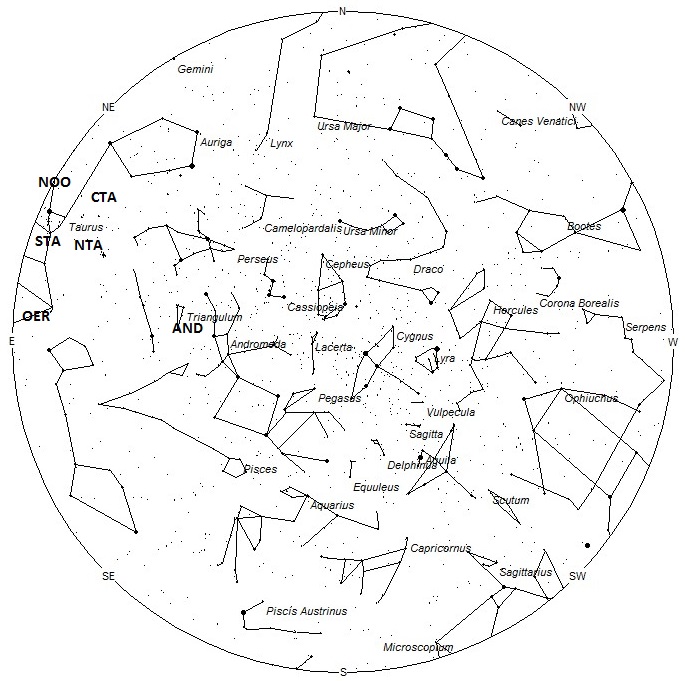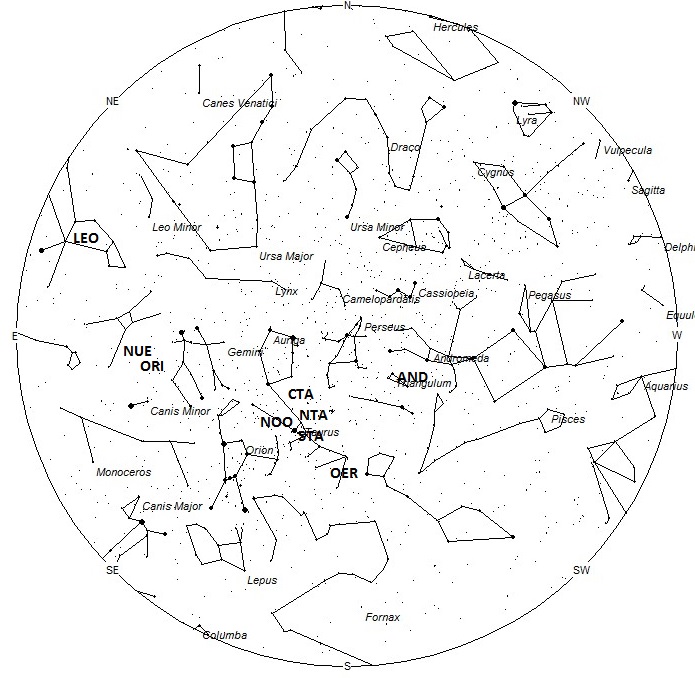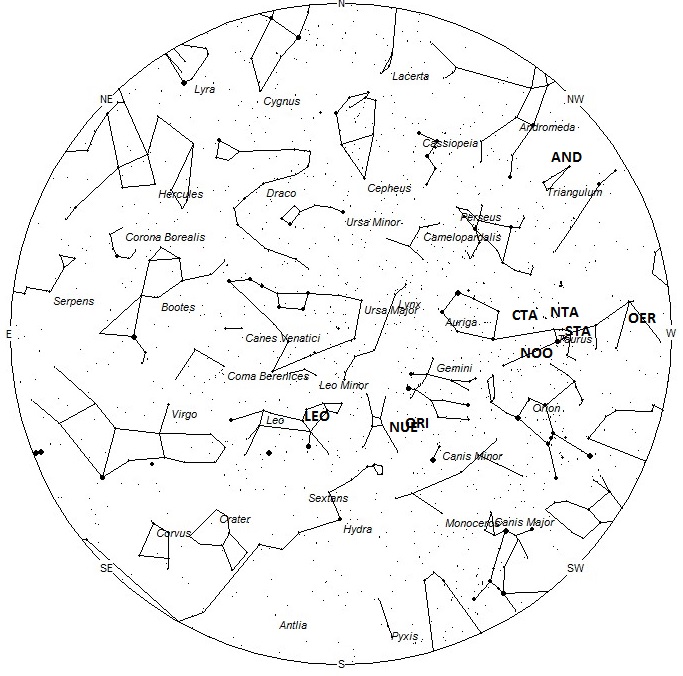During this period the moon will reach its last quarter phase on Saturday November 11th. At this time the half-illuminated moon will rise near midnight local standard time (LST) and will remain above the horizon the remainder of the night. The moon will be bright but successful meteor watches can be conducted if you face away from the lunar glare. Viewing circumstances improve with each passing night as the moon’s phase wanes and it rises later in the morning. The estimated total hourly meteor rates for evening observers this week is near 4 as seen from mid-northern latitudes (45N) and 3 as seen from tropical southern locations (25S). For morning observers the estimated total hourly rates should be near 18 as seen from mid-northern latitudes and 10 from the southern tropics. The actual rates will also depend on factors such as personal light and motion perception, local weather conditions, alertness and experience in watching meteor activity. Morning rates are reduced during this period due to interfering moonlight. Note that the hourly rates listed below are estimates as viewed from dark sky sites away from urban light sources. Observers viewing from urban areas will see less activity as only the brighter meteors will be visible from such locations.
The radiant (the area of the sky where meteors appear to shoot from) positions and rates listed below are exact for Saturday night/Sunday morning November 11/12. These positions do not change greatly day to day so the listed coordinates may be used during this entire period. Most star atlases (available at science stores and planetariums) will provide maps with grid lines of the celestial coordinates so that you may find out exactly where these positions are located in the sky. A planisphere or computer planetarium program is also useful in showing the sky at any time of night on any date of the year. Activity from each radiant is best seen when it is positioned highest in the sky, either due north or south along the meridian, depending on your latitude. It must be remembered that meteor activity is rarely seen at the radiant position. Rather they shoot outwards from the radiant so it is best to center your field of view so that the radiant lies near the edge and not the center. Viewing there will allow you to easily trace the path of each meteor back to the radiant (if it is a shower member) or in another direction if it is a sporadic. Meteor activity is not seen from radiants that are located far below the horizon. The positions below are listed in a west to east manner in order of right ascension (celestial longitude). The positions listed first are located further west therefore are accessible earlier in the night while those listed further down the list rise later in the night.
These sources of meteoric activity are expected to be active this week.
.
The Andromedids (AND) are active from October 26 through November 17 with maximum activity occurring on November 5. The radiant is currently located at 01:51 (028) +31, which lies in western Triangulum, just northwest of the 3rd magnitude star known as alpha Trianguli. Rates should be near 1 per hour as seen from the northern hemisphere and less than 1 as seen from south of the equator. The radiant is best located near 22:00 (10pm) LST when the radiant lies highest above the horizon. With an entry velocity of 18 km/sec., the average Andromedid meteor would be of slow velocity.
The Northern Taurids (NTA) are active from a large radiant located at 03:57 (059) +23. This area of the sky is located in northwestern Taurus, 3 degrees southeast of the naked eye open cluster known as the Pleiades. This position is close to the Southern Taurids so great care must be taken in separating these meteors. You must have the two radiants near the center of your field of view to properly differentiate these sources. Current rates would be 3 per hour as seen from the northern hemisphere and 2 per hour as seen from south of the equator. These meteors may be seen all night long but the radiant is best placed near midnight LST when it lies on the meridian and is located highest in the sky. With an entry velocity of 28 km/sec., the average Northern Taurid meteor would be of slow velocity.
The omicron Eridanids (OER) were discovered by Japanese observers using video data from SonotoCo in 2007-2008. This is a weak shower that usually produces rates less than 1 per hour, even at maximum activity. The radiant is currently located at 04:06 (061) -00, which places it on the Eridanus/Taurus border, 6 degrees southeast of the 4th magnitude star known as nu Tauri. These meteors may be seen all night long but the radiant is best placed near midnight LST when it lies on the meridian and is located highest in the sky. With an entry velocity of 29 km/sec., the average omicron Eridanid meteor would be of slow velocity.
The Southern Taurids (STA) are active from a large radiant centered near 04:07 (062) +16. This position lies in central Taurus, 5 degrees west of the orange 1st magnitude star known as Aldebaran (alpha Tauri). These meteors may be seen all night long but the radiant is best placed near midnight LST when it lies on the meridian and is located highest in the sky. Rates at this time should be near 2 per hour regardless of your location. With an entry velocity of 27 km/sec., the average Southern Taurid meteor would be of slow velocity.
The chi Taurids (CTA) were discovered by Dr. Peter Brown during his 7 year survey using the Canadian Meteor Orbit Radar (CMOR). This source is active from October 20 through November 17 with a maximum occurring near November 3rd. Current rates should be near 1 per hour as seen from the northern hemisphere and less than 1 as seen from south of the equator. The radiant is currently located at 04:51 (073) +28, which places it in northern Taurus, 8 degrees west of the 2nd magnitude star known as El Nath (beta Tauri). These meteors may be seen all night long but the radiant is best placed near 0100 LST when it lies on the meridian and is located highest in the sky. With an entry velocity of 41 km/sec., the average chi Taurid meteor would be of medium velocity.
The November Orionids (NOO) are now active from a radiant located at 04:55 (074) +16. This area of the sky lies in central Taurus, 4 degrees east of the 1st magnitude orange star known as Aldebaran (alpha Tauri). This area of the sky is best placed in the sky near 0100 LST, when it lies highest above the horizon. This stream is active from November 7 through December 17, with maximum activity occurring on November 29. Rates should be near 1 per hour no matter your location. With an entry velocity of 43 km/sec., most activity from this radiant would be of medium speed.
The Orionids (ORI) are still active from a radiant located at 07:50 (118) +15, which places it in eastern Gemini, almost directly between the bright stars known as Pollux (beta Geminorum) and Procyon (alpha Canis Minoris). This area of the sky is best placed in the sky near 0400 LST, when it lies highest above the horizon in a dark sky. Rates should be near 1 per hour no matter your location. With an entry velocity of 67 km/sec., most activity from this radiant would be of swift speed.
The last of the nu Eridanids (NUE) should be seen during this period from a radiant located at 08:15 (124) +16. This area of the sky lies in central Cancer, 2 degrees southeast of the faint star known as zeta Cancri. This area of the sky is best seen during the last dark hour before dawn when the radiant lies highest in a dark sky. This position is also very close the the Orionid radiant and some experts feel that these two sources are related. To separate any possible nu Eridanids from the stronger Orionids one must face in a direction so that both radiant are well within your field of view. Current rates are expected to be less than 1 per hour during this period no matter your location. With an entry velocity of 67 km/sec., the average meteor from this source would be of swift velocity.
Activity from the Leonids (LEO) should now be visible in the morning sky. This well-known shower is active from November 2-30 with maximum activity occurring near November 17th. The radiant is currently located at 10:02 (151) +23. This area of the sky is located in western Leo, 3 degrees west of the 3rd magnitude star known as Adhafera (zeta Leonis). Rates are expected to be near 1 per hour this weekend increasing to 2-3 by the end of the week. Rates seen from the southern hemisphere will be slightly lower. These meteors are best seen during the last hour before dawn when the radiant lies highest above the horizon in a dark sky. With an entry velocity of 70 km/sec., the average Leonid meteor would be of swift velocity.
As seen from the mid-northern hemisphere (45N) one would expect to see approximately 8 sporadic meteors per hour during the last hour before dawn as seen from rural observing sites. Evening rates would be near 3 per hour. As seen from the tropical southern latitudes (25S), morning rates would be near 4 per hour as seen from rural observing sites and 2 per hour during the evening hours. Locations between these two extremes would see activity between the listed figures. Morning rates are reduced during this period due to moonlight.
The list below offers the information from above in tabular form. Rates and positions are exact for Saturday night/Sunday morning except where noted in the shower descriptions.
| SHOWER | DATE OF MAXIMUM ACTIVITY | CELESTIAL POSITION | ENTRY VELOCITY | CULMINATION | HOURLY RATE | CLASS |
| RA (RA in Deg.) DEC | Km/Sec | Local Standard Time | North-South | |||
| Andromedids (AND) | Nov 05 | 01:51 (028) +31 | 18 | 22:00 | 1 – <1 | III |
| Northern Taurids (NTA) | Nov 02 | 03:57 (059) +23 | 28 | 00:00 | 3 – 2 | II |
| omicron Eridanids (OER) | Nov 04 | 04:06 (061) -00 | 29 | 00:00 | <1 – <1 | IV |
| Southern Taurids (STA) | Oct 29-Nov 03 | 04:07 (062) +16 | 27 | 00:00 | 2 – 2 | II |
| chi Taurids (CTA) | Nov 03 | 04:51 (073) +28 | 41 | 01:00 | 1 – <1 | IV |
| November Orionids (NOO) | Nov 29 | 04:55 (074) +16 | 43 | 01:00 | 1 – 1 | II |
| Orionids (ORI) | Oct 22 | 07:50 (118) +15 | 67 | 04:00 | 1 – 1 | I |
| nu Eridanids (NUE) | Sep 08 | 08:15 (124) +16 | 67 | 05:00 | <1 – <1 | IV |
| Leonids (LEO) | Nov 17 | 10:02 (151) +23 | 70 | 07:00 | 1 – <1 | I |








